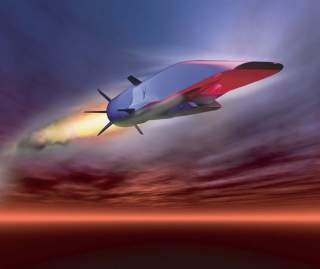How Hypersonic Missiles Push America and China towards War
"Hypersonic weapons add to the complexity and elusiveness of the escalatory dynamics and this is something both sides will need to plan for."
The main drivers behind escalation are two: firstly, hypersonic weapons are escalation prone due to their low levels of responsiveness once they are initiated, and limited capabilities for signaling given their high speed. All these make a surprise attack an eventuality the other side needs to account for pushing both parties to seizing the initiative early which leaves no room for signaling and diplomacy.
Secondly, within the context of China’s “double deterrence,” according to Thomas Christensen, both nuclear and conventional ballistic forces are put under the same command. This strategic move, in essence, “manufactures” an inadvertent escalation scenario where an eventual American surgical strike against conventional systems inadvertently engages with nuclear targets. Put simply, the objective is to deter the adversary from implementing surgical strikes under the “manufactured” threat of inadvertent escalation.
In conclusion, what is the significance of all these questions for U.S. military planning and doctrines? In one sentence, both parties need to embrace the idea of “two-sided escalation situations”. Both the Joint Operational Access Concept (JOAC) and Air-Sea Battle (now called JAM-GC) seem to place the emphasis on a war-fighting concept that seeks to prevent the adversary from escalating (escalation dominance) instead of influencing its decision to escalate. In other words, military thinking so far has been dominated by the use of brute force, as Schelling would call it, instead of coercive force that leaves the final choice to the opponent. The latter would be more expedient in a regional conflict scenario where the United States faces a nuclear force while at the same time the objective at stake does not justify an all-out war effort. That said, any anti-A2/AD strategy must borrow more from a crisis-stability scenario rather than a purely war-fighting one, given that deterrence will be an important part of the war effort. Such an approach comes in tandem with an emphasis on the notion of escalation management to reinforce stability rather than escalation dominance or control, which could come with destabilizing effects. It is difficult for both sides to accept but escalation control is at least wishful thinking if not an illusion in the East Asian regional environment. Hypersonic weapons add to the complexity and elusiveness of the escalatory dynamics and this is something both sides will need to plan for.
Eleni G. Ekmektsioglou is pursuing her PhD at American University’s School of International Service. Her research focuses on the impact of military innovation on crisis management. She is a non-resident fellow at Pacific Forum CSIS.
Editor’s Note: This piece draws from the author’s work in Strategic Studies Quarterly - “Hypersonic Weapons and Escalation Control in East Asia” which can be found here.

